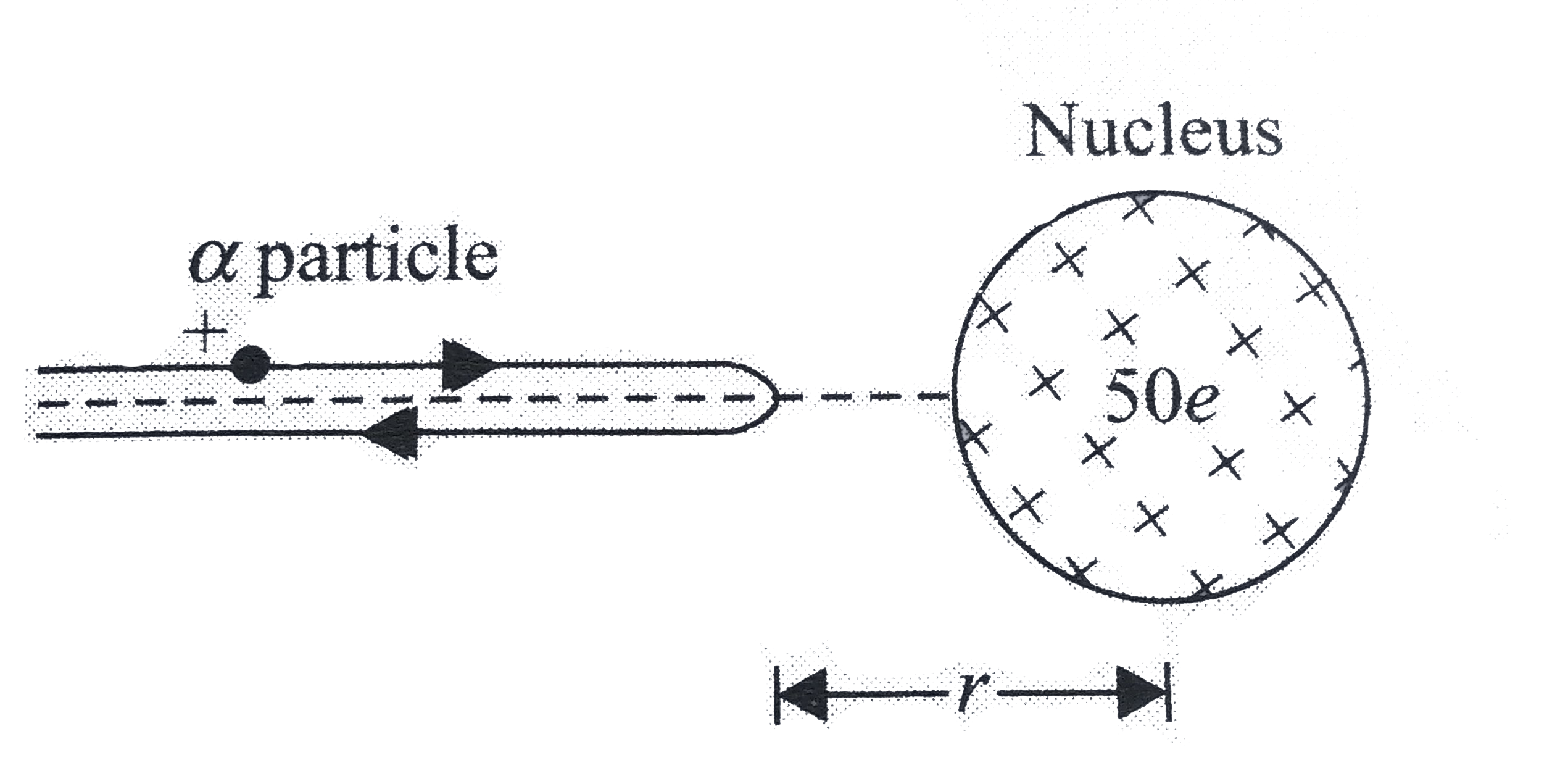An alpha particle having KE equal to 8.7MeV is projected towards the nucleus of copper with Z=29. Calculate its distance of closest approach.
The correct Answer is:9.6×10−15m
To find the distance of closest approach of an alpha particle to a copper nucleus, we can use the formula:
r0=14πϵ0⋅Ze⋅2eK
Where:
- r0 is the distance of closest approach,
- Z is the atomic number of the copper nucleus (which is 29),
- e is the charge of an electron (1.6×10−19C),
- K is the kinetic energy of the alpha particle,
- ϵ0 is the permittivity of free space (8.85×10−12C2/N m2).
Step 1: Convert Kinetic Energy from MeV to Joules
The kinetic energy of the alpha particle is given as 8.7MeV. To convert this to joules, we use the conversion factor 1MeV=1.6×10−13J:
K=8.7MeV×1.6×10−13J/MeV=1.392×10−12J
Step 2: Substitute Values into the Formula
Now we substitute the known values into the formula for r0:
r0=14π(8.85×10−12)⋅(29)(1.6×10−19)⋅2(1.6×10−19)1.392×10−12
Step 3: Calculate the Numerator
First, calculate the numerator:
Numerator=29⋅1.6×10−19⋅2⋅1.6×10−19=29⋅2.56×10−38=7.424×10−38
Step 4: Calculate the Denominator
Now calculate the denominator:
Denominator=4π(8.85×10−12)⋅1.392×10−12
Calculating 4π≈12.566:
Denominator≈12.566⋅8.85×10−12⋅1.392×10−12≈1.1×10−22
Step 5: Final Calculation of r0
Now we can calculate r0:
r0=7.424×10−381.1×10−22≈6.75×10−15m
Step 6: Conclusion
Thus, the distance of closest approach r0 is approximately:
r0≈6.75×10−15m
- r0 is the distance of closest approach,
- Z is the atomic number of the copper nucleus (which is 29),
- e is the charge of an electron (1.6×10−19C),
- K is the kinetic energy of the alpha particle,
- ϵ0 is the permittivity of free space (8.85×10−12C2/N m2).
The kinetic energy of the alpha particle is given as 8.7MeV. To convert this to joules, we use the conversion factor 1MeV=1.6×10−13J:
Now we substitute the known values into the formula for r0:
First, calculate the numerator:
Now calculate the denominator:
Now we can calculate r0:
Thus, the distance of closest approach r0 is approximately:
Topper's Solved these Questions
- BOOK - PRADEEPCHAPTER - ATOMS AND NUCLEIEXERCISE - Fill in the blank 21videos
ATOMS AND NUCLEI
- BOOK - PRADEEPCHAPTER - ATOMS AND NUCLEIEXERCISE - Multiple choice questions 11videos
ATOMS AND NUCLEI
- BOOK - PRADEEPCHAPTER - ATOMS AND NUCLEIEXERCISE - curiocity quetions 31videos
ATOMS AND NUCLEI
- BOOK - PRADEEPCHAPTER - COMMUNICATION SYSTEMSEXERCISE - MODEL TEST PAPER-29videos
COMMUNICATION SYSTEMS
Similar Questions
Knowledge Check
- Question 1 - Select One
If an α-particle is incident directly towards a nucleus then it will stop when the distance between them is the distance of closest approach. Which of these is correct?
AIts kinetic energy is converted into released radiationBWhen its kinetic energy becomes zero then it converts into electrostatic potential energyCAt distance of closest approach the potential energy of the α-particle becomes zeroDA β-particle will show the same behaviour as an α-particle - Question 2 - Select One
A beam of beryllium nucleus (z = 4) of kinetic energy 5.3 MeV is headed towards the nucleus of gold atom (Z = 79). What is the distance of closest approach?
A10.32×10−14mB8.58×10−14mC3.56×10−14mD1.25×10−14m - Question 3 - Select One
When an α particle of mass m moving with velocity v bombards on a heavy nucleus of charge Ze, its distance of closest approach form the nucleus depends on m as
A1√mB1m2CmD1m
An α-particle with kinetic energy K is heading towards a stationary nucleus of atomic number Z. Find the distance of the closest approach.
View SolutionAn alpha particle of velocity 1.6×107ms−1 approaches a gold nucleus (Z=79). Calculate the distance of the closest approach. Mass of an alpha particle is 6.6×10−27 kg. What is the significance of this closest approach?
View SolutionAn alpha particle with kinetic energy 10MeV is heading toward a stationary tin nuclcus of atomic number 50. Calculate the distance of closest approach (Fig . 3.23).
 .View Solution
.View SolutionA n α-particle of velocity 1.6×107ms−1 approaches a gold nucleii (Z=79). Calculate the distance of closest approach. Mas of an α-particle =6.6×10−27kg.
View SolutionWhen an α−particle of mass 'm' moving with velocity 'v' bombards on a heavy nucleus of charge 'Ze' its distance of closest approach from the nucleus depends on m as :
View Solution

